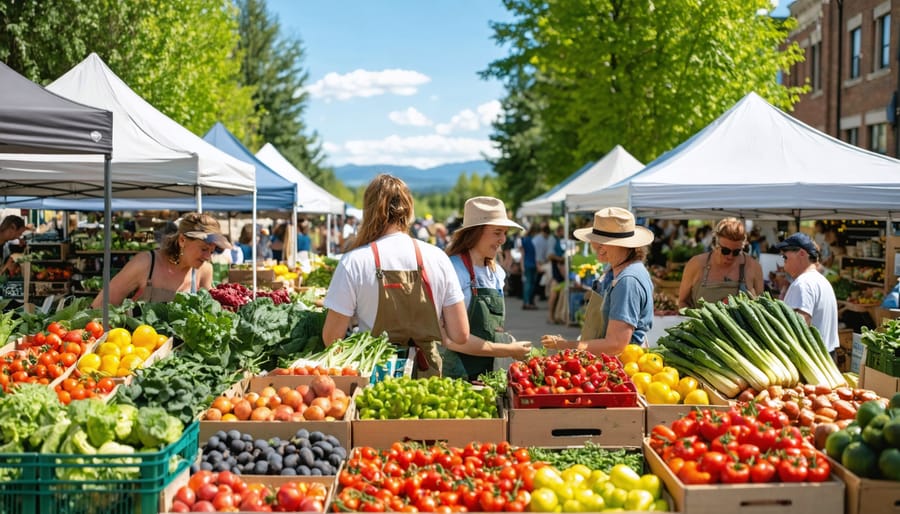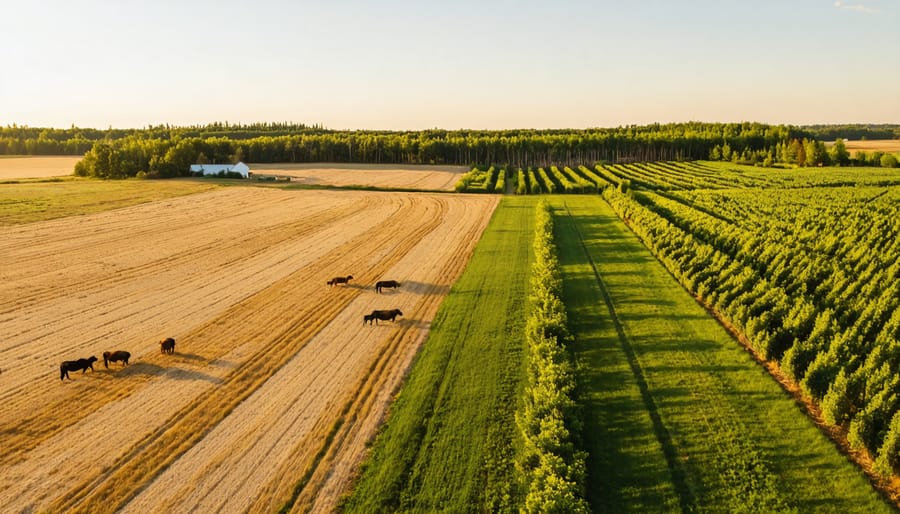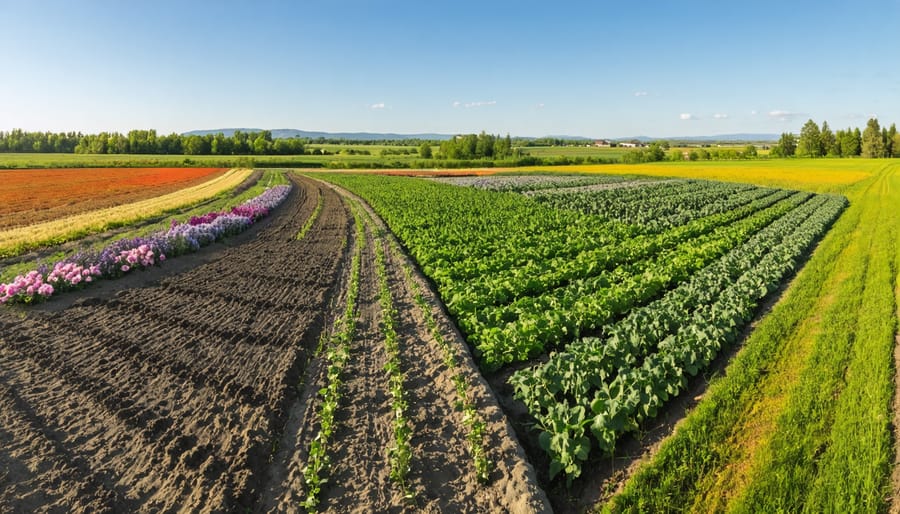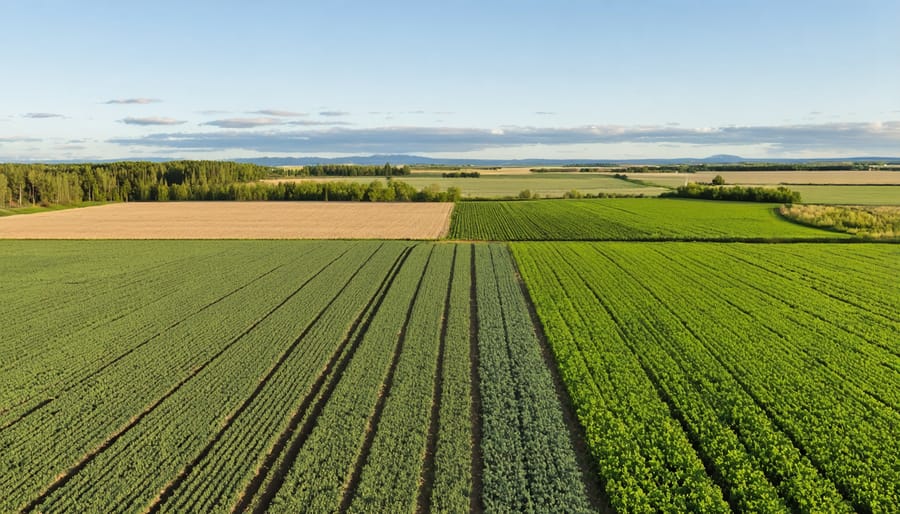Local food systems are transforming Canadian agriculture, creating resilient economic networks that connect Alberta’s farmers directly with their communities. From farm-gate sales reaching $1.2 billion annually to innovative food hubs serving over 400 regional producers, these systems are reshaping how we grow, distribute, and consume food across the province.
The shift towards local food networks isn’t just about reducing food miles – it’s about building sustainable agricultural businesses that can weather market fluctuations while meeting growing consumer demand for transparency and connection to their food sources. When farmers sell directly to local markets, they capture up to 80% of the food dollar, compared to just 15% in conventional supply chains.
Our research across Alberta’s agricultural communities shows that farms participating in local food systems report 25% higher net returns and create three times more local jobs than those focused solely on commodity markets. These systems also strengthen community food security, with 65% of participating farms expanding production during recent supply chain disruptions.
This practical guide explores how Canadian farmers can tap into these opportunities, drawing from successful case studies across Alberta’s diverse agricultural landscape – from Peace Country’s grain producers to Southern Alberta’s market gardeners.
The Economic Power of Local Food Networks
Direct-to-Consumer Sales: A Game-Changing Strategy
Direct-to-consumer sales have revolutionized how Alberta farmers connect with their communities while maximizing their profit margins. Through farmers’ markets, Community Supported Agriculture (CSA) programs, and farm-gate sales, producers are cutting out middlemen and building lasting relationships with their customers.
Farmers’ markets continue to thrive across Alberta, with over 130 approved markets generating more than $1.2 billion in annual sales. These bustling community hubs allow farmers to receive full retail price for their products while gathering valuable customer feedback. For example, Red Deer farmer Sarah Thompson saw her revenue increase by 40% after establishing a regular presence at her local market.
CSA programs have gained significant traction, offering farmers guaranteed income through pre-season subscriptions. Members typically pay $500-800 for a season’s worth of weekly produce boxes, providing farmers with essential early-season capital. The Harvest Share program in Lacombe County demonstrates this model’s success, growing from 25 to 150 members in just three years.
Farm-gate sales, where customers purchase directly at the farm, have become increasingly popular, especially since 2020. This model reduces transportation costs and creates authentic farm experiences for visitors. Many Alberta farmers have enhanced their farm-gate operations by adding online pre-ordering systems and contactless pickup options.
Success in direct sales often comes from combining multiple channels. The key is starting small and scaling based on demand. Consider beginning with a farmers’ market stall, then expanding to CSA offerings as you build a customer base. Remember to check local regulations and food safety requirements before launching any direct-sales initiative.
Through these direct-to-consumer channels, farmers are not just selling food – they’re building community connections and securing their farm’s financial future.
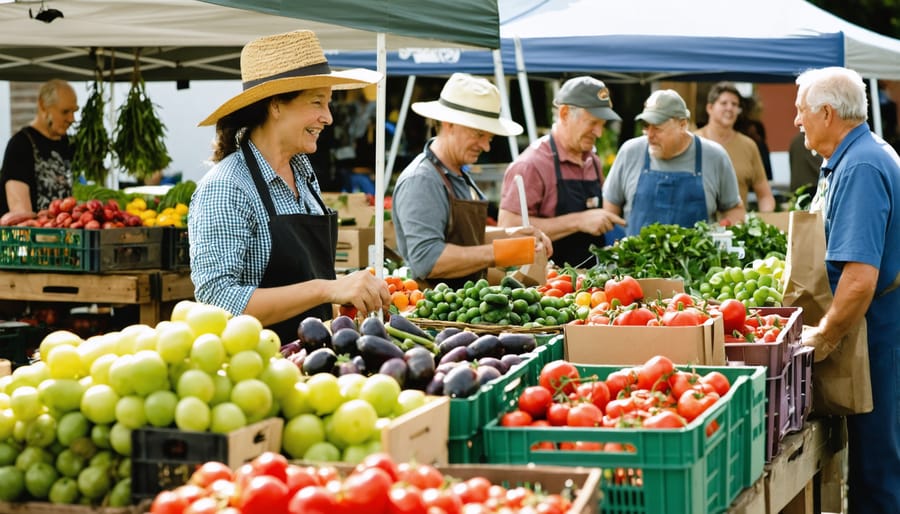
Building Regional Food Processing Infrastructure
The development of regional food processing infrastructure represents a crucial step in strengthening local food systems across Alberta. As more farmers work towards establishing greener supply chains, access to local processing facilities has become increasingly important for creating value-added products and maintaining product quality.
Several communities have successfully established shared processing facilities, like the Vulcan Food Processing Centre, which allows multiple producers to access commercial-grade equipment for processing vegetables, meats, and other agricultural products. These facilities typically offer services such as flash-freezing, packaging, and storage solutions, enabling farmers to extend their selling season and diversify their product offerings.
The economic benefits of local processing facilities are substantial. Farmers can increase their profit margins by transforming raw agricultural products into value-added items such as pre-cut vegetables, preserved fruits, or prepared meals. For example, the Innisfail Growers cooperative has leveraged local processing facilities to create ready-to-eat salad mixes, increasing their revenue by 40% compared to selling whole vegetables.
Investment in processing infrastructure also creates year-round employment opportunities and keeps more economic activity within the community. The Red Deer Food Processing Innovation Centre demonstrates how these facilities can support both established producers and new entrepreneurs in product development and testing.
To access these opportunities, farmers can:
– Partner with existing facilities through shared-use agreements
– Join or form cooperatives to pool resources for processing equipment
– Apply for provincial grants supporting value-added agriculture
– Collaborate with local economic development offices to identify processing opportunities
Creating strong regional processing infrastructure takes time, but the investment strengthens local food security while providing sustainable income streams for producers.
Strengthening Community Food Security

Success Story: The Red Deer Food Hub Initiative
The Red Deer Food Hub Initiative stands as a shining example of how local food systems can transform rural economies. Launched in 2019, this collaborative project brought together 45 small-scale producers from central Alberta to create a centralized distribution network that now serves over 2,000 households and 25 restaurants in the region.
The hub operates from a renovated warehouse facility, equipped with cold storage and processing areas, where farmers can aggregate their produce, meat, and value-added products. This shared infrastructure has reduced individual operating costs by approximately 30% for participating farmers, while expanding their market reach significantly.
What makes the Red Deer model particularly successful is its innovative scheduling system. Farmers coordinate their planting and harvest schedules through a digital platform, ensuring consistent supply throughout the growing season. This coordination has resulted in a 40% increase in participating farmers’ annual revenue since the hub’s inception.
The initiative also created 12 full-time jobs and established partnerships with local schools for educational programs about agriculture and nutrition. Perhaps most notably, the hub has reduced food transportation distances by an average of 150 kilometers per delivery, resulting in fresher products for consumers and lower carbon emissions.
Today, the Red Deer Food Hub serves as a blueprint for other communities, demonstrating how strategic collaboration and smart infrastructure investment can create a thriving local food economy that benefits producers and consumers alike.
Environmental Benefits That Boost Your Bottom Line
Reducing Transportation Costs and Carbon Footprint
Local distribution networks significantly reduce both transportation costs and environmental impact. Alberta farmers implementing circular food systems have reported fuel cost savings of up to 40% when compared to traditional distribution methods. For example, the Lacombe County Food Hub consolidates deliveries from multiple farms, reducing individual transport runs and sharing delivery costs among participants.
A recent study of Southern Alberta producers showed that farms within 100 kilometres of urban markets saved an average of $0.75 per kilometer in transport costs through collaborative delivery systems. This translates to approximately $3,000 in annual savings for a mid-sized operation making weekly deliveries.
Beyond the financial benefits, reduced transport distances mean fewer emissions. Local producers in the Edmonton region collectively decreased their carbon emissions by 15 tonnes annually by implementing shared distribution networks. Simple solutions, such as coordinated delivery schedules and community drop-off points, have proven effective in maximizing load efficiency while minimizing fuel consumption.
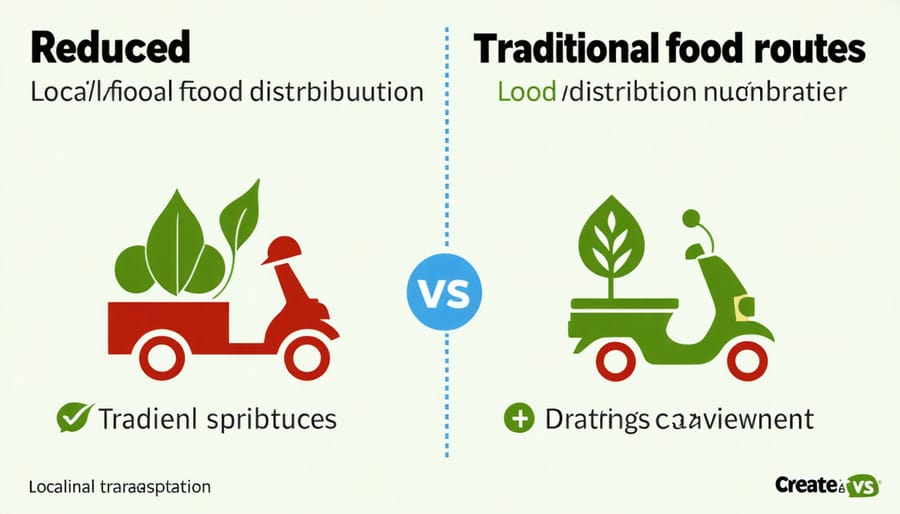
Practical Steps to Join Local Food Networks
Getting involved in local food networks can transform your farming operation into a more sustainable farm livelihood. Start by attending farmers’ markets and agricultural events in your region to connect with other producers and potential buyers. The Alberta Farmers’ Market Association offers resources and networking opportunities specifically designed for local producers.
Create a profile on digital platforms like Local Harvest or Open Food Network Canada to increase your visibility. These tools help connect you directly with consumers and restaurants seeking local produce. Consider joining a cooperative or producer group in your area, which can provide shared resources and collective bargaining power.
Develop relationships with nearby restaurants, schools, and institutions. Many are actively seeking local suppliers through farm-to-table initiatives. Start small by approaching one or two potential partners and gradually expand your network.
Investigate food hub opportunities in your region. These distribution centres can handle logistics and connect you with multiple buyers. The Alberta Food Hub Network offers support for farmers looking to participate in these collaborative systems.
Consider value-added opportunities that can extend your selling season and increase profitability. This might include processing your products or partnering with local food processors. Remember to review and comply with local food safety regulations and certification requirements before expanding your operation.
Document your farming practices and story, as consumers increasingly value transparency and connection to their food sources. Share these through social media and your farm’s website to build trust and attract customers committed to supporting local agriculture.
Local food systems represent a powerful opportunity for Canadian farmers to strengthen their operations while building more resilient communities. By participating in these systems, producers can secure better profit margins through direct marketing, reduce transportation costs, and develop lasting relationships with customers who value locally-grown food. The benefits extend beyond individual farms, creating positive ripple effects throughout our regional economies and helping to preserve agricultural heritage for future generations.
The evidence from successful local food initiatives across Alberta demonstrates that when farmers, consumers, and local businesses work together, everyone benefits. From farmers’ markets in Edmonton to community-supported agriculture programs in rural communities, these systems are proving their economic viability while enhancing food security and environmental sustainability.
As we look to the future of Canadian agriculture, embracing local food systems offers a practical path forward. Whether you’re considering transitioning part of your operation to direct marketing or exploring partnerships with local retailers, there’s never been a better time to get involved. By taking even small steps toward participating in your local food system, you’re contributing to a more sustainable and profitable agricultural sector for all Albertans.

